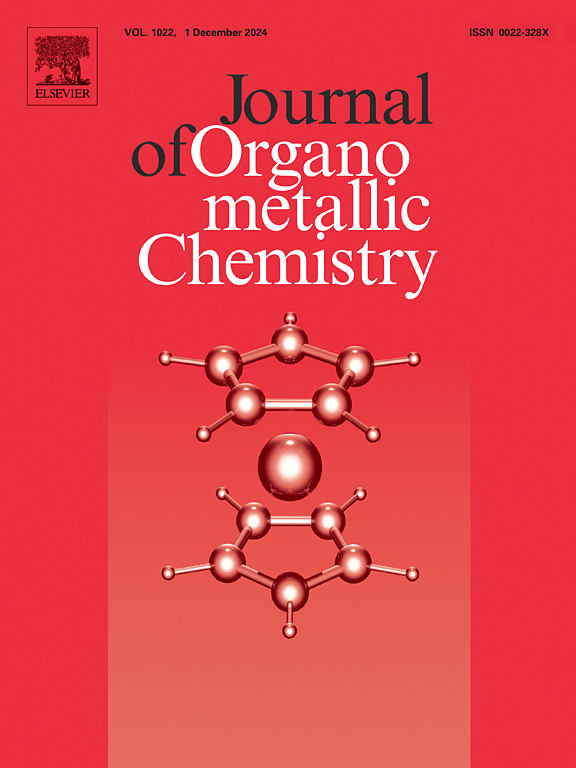Synthesis and protonation reactions of nitrosyl complexes [M2Cp(μ-κ:η5-C5H4)(μ-PR2)(CO)(NO)2] to give κ:η-NO-bridged derivatives (M = Mo, W; R = Cy, tBu)
IF 2.1
3区 化学
Q3 CHEMISTRY, INORGANIC & NUCLEAR
引用次数: 0
Abstract
The title compounds were prepared upon reaction of BAr’4− salts of the known cations [M2Cp2(μ-PR2)(CO)2(NO)2]+ (M = Mo, W; R = Cy, tBu; Ar’ = 3,5-C6H3(CF3)2), with commercial Me3NO·2H2O in fluorobenzene solution at 273 K, this promoting decarbonylation and cyclopentadienyl deprotonation to yield complexes with cyclopentadienylidene ligands bridging the metal centres (W−W = 2.9917(5) Å when R = Cy). The use of dichloromethane as solvent, however, triggered a competitive chloride abstraction reaction by the Mo compounds that yielded the chloride complexes [Mo2Cp2Cl(μ-PR2)(CO)(NO)2], specifically formed with an anti disposition of the Cp ligands relative to the Mo2P plane, and cis positioning of carbonyl and chloride ligands relative to the P atom (Mo−Cl = 2.336(4) Å when R = tBu). Protonation of the cyclopentadienylidene-bridged complexes with [H(OEt2)2](BAr’4) yielded the BAr’4− salts of the dicyclopentadienyl cations [M2Cp2(μ-κ:η-NO)(μ-PR2)(CO)(NO)]+ (Mo−Mo = 3.1027(2) Å when R = tBu; W−W = 3.0446(7) Å when R = Cy), which display bridging nitrosyl ligands in the rare linear end-on:side-on coordination mode, and are kinetic rather than thermodynamic products, according to density functional theory calculations. When using HBF4·OEt2 as protonation reagent on the PtBu2-bridged complexes, however, coordination of the external anion (in the κ1-mode) also takes place, to yield the tetrafluoroborate complexes [M2Cp2(κ1-BF4)(μ-PtBu2)(CO)(NO)2] as unique (Mo) or major (W) products. Methylation of the same cyclopentadienylidene complexes with [Me3O](BF4) was only observed for the tungsten cation, and took place specifically at the O atom of one nitrosyl ligand to give [W2Cp(μ-κ:η5-C5H4)(NOMe)(μ-PtBu2)(CO)(NO)](BF4), a complex displaying a linear methoxyimido ligand (W−N = 1.746(4) Å; W−N−O = 163.5(4)o).

求助全文
约1分钟内获得全文
求助全文
来源期刊

Journal of Organometallic Chemistry
化学-无机化学与核化学
CiteScore
4.40
自引率
8.70%
发文量
221
审稿时长
36 days
期刊介绍:
The Journal of Organometallic Chemistry targets original papers dealing with theoretical aspects, structural chemistry, synthesis, physical and chemical properties (including reaction mechanisms), and practical applications of organometallic compounds.
Organometallic compounds are defined as compounds that contain metal - carbon bonds. The term metal includes all alkali and alkaline earth metals, all transition metals and the lanthanides and actinides in the Periodic Table. Metalloids including the elements in Group 13 and the heavier members of the Groups 14 - 16 are also included. The term chemistry includes syntheses, characterizations and reaction chemistry of all such compounds. Research reports based on use of organometallic complexes in bioorganometallic chemistry, medicine, material sciences, homogeneous catalysis and energy conversion are also welcome.
The scope of the journal has been enlarged to encompass important research on organometallic complexes in bioorganometallic chemistry and material sciences, and of heavier main group elements in organometallic chemistry. The journal also publishes review articles, short communications and notes.
 求助内容:
求助内容: 应助结果提醒方式:
应助结果提醒方式:


